Report: Issues and Strategies for Managing Across Cultures
VerifiedAdded on 2023/06/04
|9
|2241
|482
Report
AI Summary
This report delves into the critical aspects of managing teams across diverse cultural backgrounds. It begins by highlighting the increasing importance of cross-cultural management in today's globalized business environment. The report identifies key issues faced by managers, such as language barriers, cultural clashes, differing work ethics, and communication challenges. It then explores effective strategies for managers to navigate these complexities, including the importance of understanding cultural values, fostering open communication, embracing diversity, providing diversity training, and adopting a democratic management style. The report emphasizes the benefits of a diverse workforce, including the generation of new ideas and perspectives, and concludes by summarizing the key takeaways and the importance of intercultural competence for organizational success. The report also references several academic sources to support the claims made.

Running Head: MANAGING ACROSS CULTURES 0
Managing across cultures
Managing across cultures
Paraphrase This Document
Need a fresh take? Get an instant paraphrase of this document with our AI Paraphraser
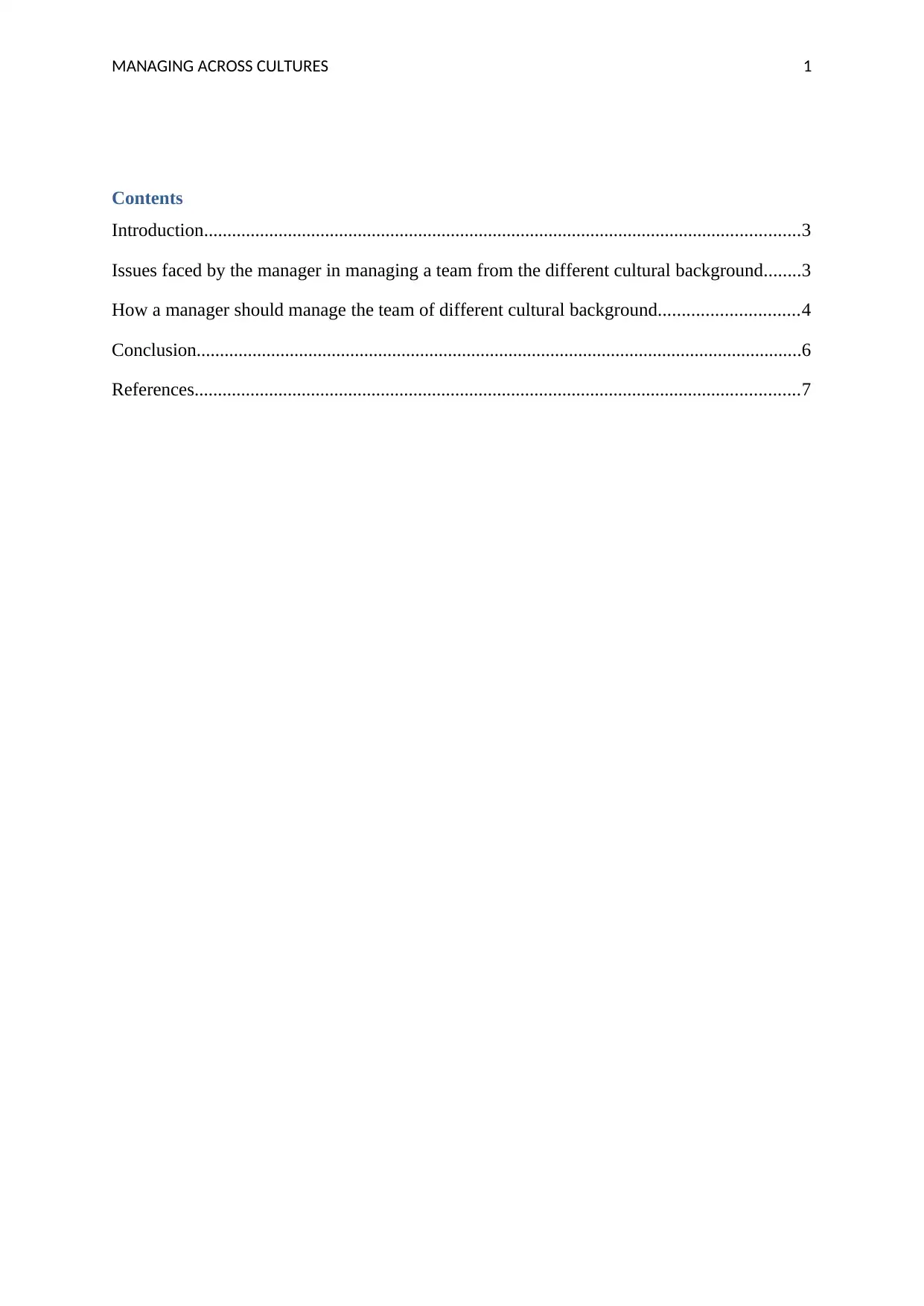
MANAGING ACROSS CULTURES 1
Contents
Introduction................................................................................................................................3
Issues faced by the manager in managing a team from the different cultural background........3
How a manager should manage the team of different cultural background..............................4
Conclusion..................................................................................................................................6
References..................................................................................................................................7
Contents
Introduction................................................................................................................................3
Issues faced by the manager in managing a team from the different cultural background........3
How a manager should manage the team of different cultural background..............................4
Conclusion..................................................................................................................................6
References..................................................................................................................................7
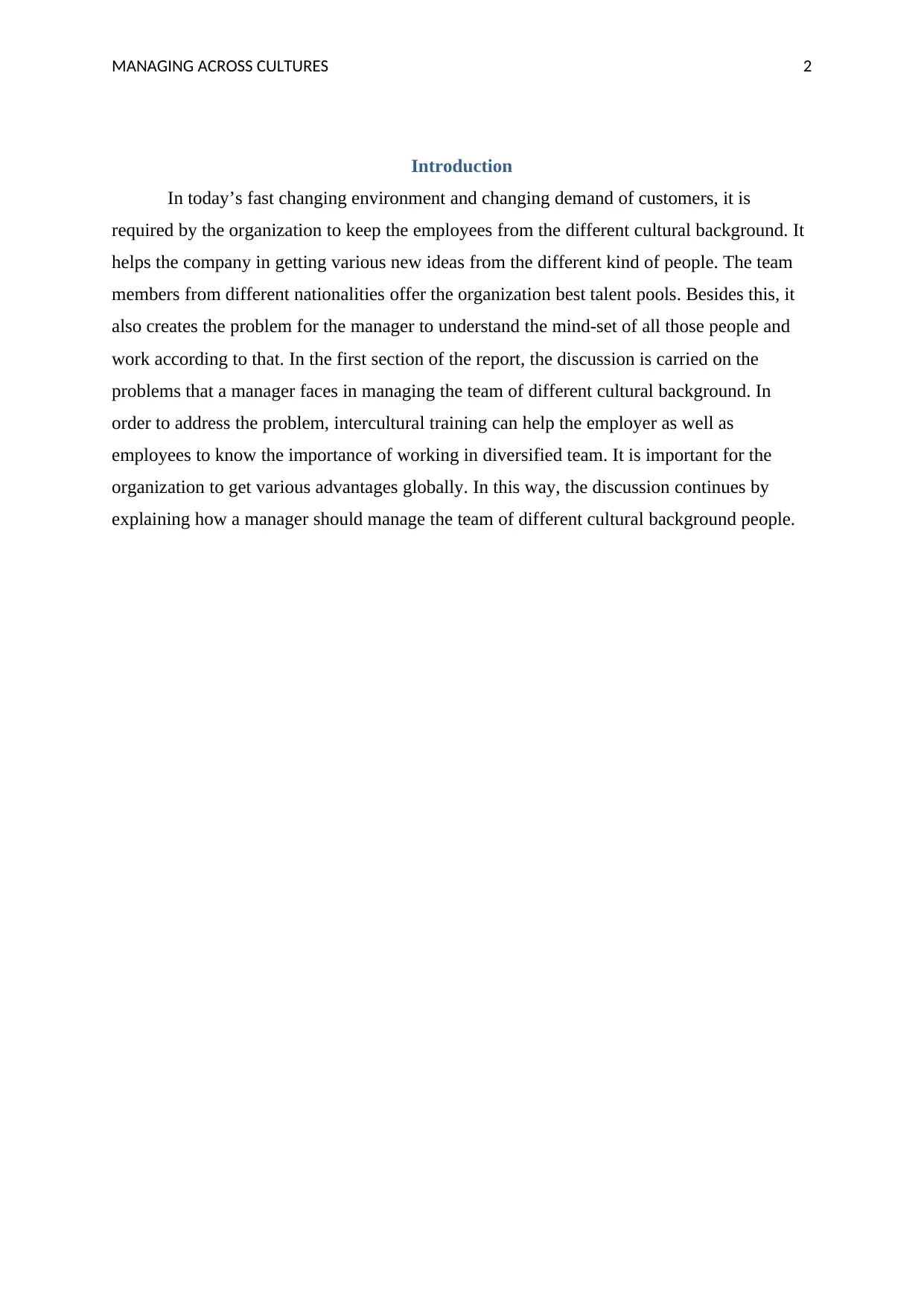
MANAGING ACROSS CULTURES 2
Introduction
In today’s fast changing environment and changing demand of customers, it is
required by the organization to keep the employees from the different cultural background. It
helps the company in getting various new ideas from the different kind of people. The team
members from different nationalities offer the organization best talent pools. Besides this, it
also creates the problem for the manager to understand the mind-set of all those people and
work according to that. In the first section of the report, the discussion is carried on the
problems that a manager faces in managing the team of different cultural background. In
order to address the problem, intercultural training can help the employer as well as
employees to know the importance of working in diversified team. It is important for the
organization to get various advantages globally. In this way, the discussion continues by
explaining how a manager should manage the team of different cultural background people.
Introduction
In today’s fast changing environment and changing demand of customers, it is
required by the organization to keep the employees from the different cultural background. It
helps the company in getting various new ideas from the different kind of people. The team
members from different nationalities offer the organization best talent pools. Besides this, it
also creates the problem for the manager to understand the mind-set of all those people and
work according to that. In the first section of the report, the discussion is carried on the
problems that a manager faces in managing the team of different cultural background. In
order to address the problem, intercultural training can help the employer as well as
employees to know the importance of working in diversified team. It is important for the
organization to get various advantages globally. In this way, the discussion continues by
explaining how a manager should manage the team of different cultural background people.
⊘ This is a preview!⊘
Do you want full access?
Subscribe today to unlock all pages.

Trusted by 1+ million students worldwide
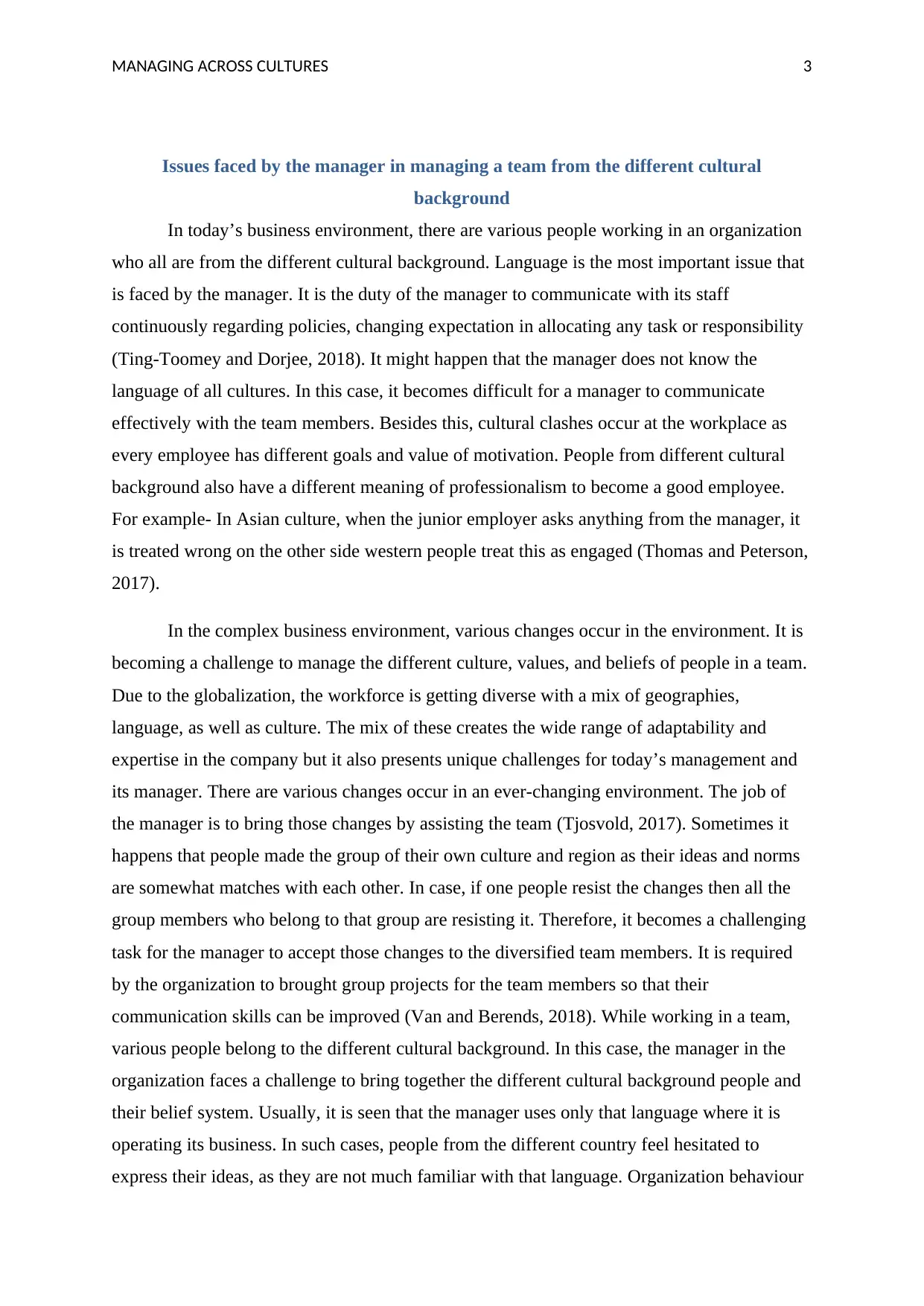
MANAGING ACROSS CULTURES 3
Issues faced by the manager in managing a team from the different cultural
background
In today’s business environment, there are various people working in an organization
who all are from the different cultural background. Language is the most important issue that
is faced by the manager. It is the duty of the manager to communicate with its staff
continuously regarding policies, changing expectation in allocating any task or responsibility
(Ting-Toomey and Dorjee, 2018). It might happen that the manager does not know the
language of all cultures. In this case, it becomes difficult for a manager to communicate
effectively with the team members. Besides this, cultural clashes occur at the workplace as
every employee has different goals and value of motivation. People from different cultural
background also have a different meaning of professionalism to become a good employee.
For example- In Asian culture, when the junior employer asks anything from the manager, it
is treated wrong on the other side western people treat this as engaged (Thomas and Peterson,
2017).
In the complex business environment, various changes occur in the environment. It is
becoming a challenge to manage the different culture, values, and beliefs of people in a team.
Due to the globalization, the workforce is getting diverse with a mix of geographies,
language, as well as culture. The mix of these creates the wide range of adaptability and
expertise in the company but it also presents unique challenges for today’s management and
its manager. There are various changes occur in an ever-changing environment. The job of
the manager is to bring those changes by assisting the team (Tjosvold, 2017). Sometimes it
happens that people made the group of their own culture and region as their ideas and norms
are somewhat matches with each other. In case, if one people resist the changes then all the
group members who belong to that group are resisting it. Therefore, it becomes a challenging
task for the manager to accept those changes to the diversified team members. It is required
by the organization to brought group projects for the team members so that their
communication skills can be improved (Van and Berends, 2018). While working in a team,
various people belong to the different cultural background. In this case, the manager in the
organization faces a challenge to bring together the different cultural background people and
their belief system. Usually, it is seen that the manager uses only that language where it is
operating its business. In such cases, people from the different country feel hesitated to
express their ideas, as they are not much familiar with that language. Organization behaviour
Issues faced by the manager in managing a team from the different cultural
background
In today’s business environment, there are various people working in an organization
who all are from the different cultural background. Language is the most important issue that
is faced by the manager. It is the duty of the manager to communicate with its staff
continuously regarding policies, changing expectation in allocating any task or responsibility
(Ting-Toomey and Dorjee, 2018). It might happen that the manager does not know the
language of all cultures. In this case, it becomes difficult for a manager to communicate
effectively with the team members. Besides this, cultural clashes occur at the workplace as
every employee has different goals and value of motivation. People from different cultural
background also have a different meaning of professionalism to become a good employee.
For example- In Asian culture, when the junior employer asks anything from the manager, it
is treated wrong on the other side western people treat this as engaged (Thomas and Peterson,
2017).
In the complex business environment, various changes occur in the environment. It is
becoming a challenge to manage the different culture, values, and beliefs of people in a team.
Due to the globalization, the workforce is getting diverse with a mix of geographies,
language, as well as culture. The mix of these creates the wide range of adaptability and
expertise in the company but it also presents unique challenges for today’s management and
its manager. There are various changes occur in an ever-changing environment. The job of
the manager is to bring those changes by assisting the team (Tjosvold, 2017). Sometimes it
happens that people made the group of their own culture and region as their ideas and norms
are somewhat matches with each other. In case, if one people resist the changes then all the
group members who belong to that group are resisting it. Therefore, it becomes a challenging
task for the manager to accept those changes to the diversified team members. It is required
by the organization to brought group projects for the team members so that their
communication skills can be improved (Van and Berends, 2018). While working in a team,
various people belong to the different cultural background. In this case, the manager in the
organization faces a challenge to bring together the different cultural background people and
their belief system. Usually, it is seen that the manager uses only that language where it is
operating its business. In such cases, people from the different country feel hesitated to
express their ideas, as they are not much familiar with that language. Organization behaviour
Paraphrase This Document
Need a fresh take? Get an instant paraphrase of this document with our AI Paraphraser
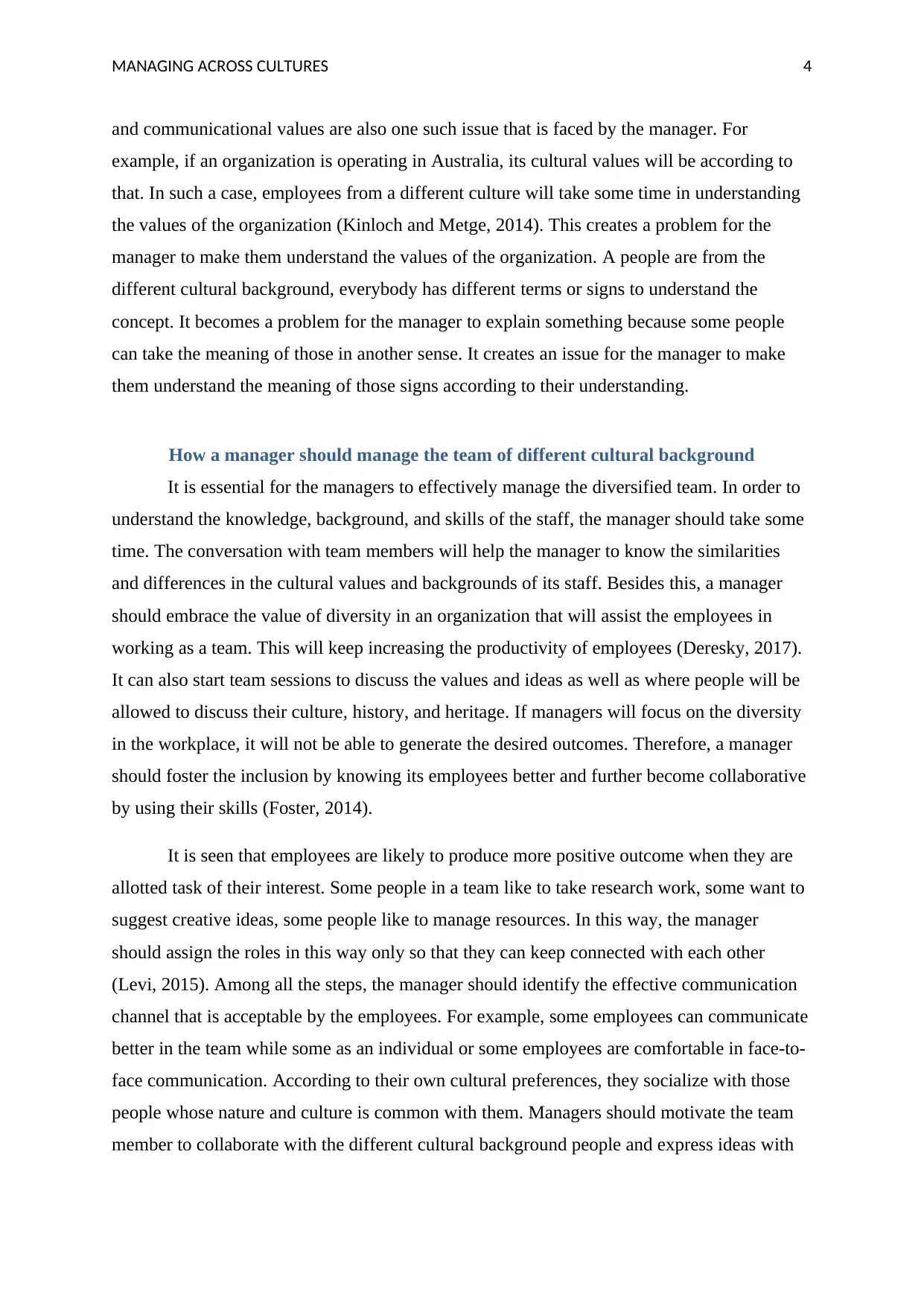
MANAGING ACROSS CULTURES 4
and communicational values are also one such issue that is faced by the manager. For
example, if an organization is operating in Australia, its cultural values will be according to
that. In such a case, employees from a different culture will take some time in understanding
the values of the organization (Kinloch and Metge, 2014). This creates a problem for the
manager to make them understand the values of the organization. A people are from the
different cultural background, everybody has different terms or signs to understand the
concept. It becomes a problem for the manager to explain something because some people
can take the meaning of those in another sense. It creates an issue for the manager to make
them understand the meaning of those signs according to their understanding.
How a manager should manage the team of different cultural background
It is essential for the managers to effectively manage the diversified team. In order to
understand the knowledge, background, and skills of the staff, the manager should take some
time. The conversation with team members will help the manager to know the similarities
and differences in the cultural values and backgrounds of its staff. Besides this, a manager
should embrace the value of diversity in an organization that will assist the employees in
working as a team. This will keep increasing the productivity of employees (Deresky, 2017).
It can also start team sessions to discuss the values and ideas as well as where people will be
allowed to discuss their culture, history, and heritage. If managers will focus on the diversity
in the workplace, it will not be able to generate the desired outcomes. Therefore, a manager
should foster the inclusion by knowing its employees better and further become collaborative
by using their skills (Foster, 2014).
It is seen that employees are likely to produce more positive outcome when they are
allotted task of their interest. Some people in a team like to take research work, some want to
suggest creative ideas, some people like to manage resources. In this way, the manager
should assign the roles in this way only so that they can keep connected with each other
(Levi, 2015). Among all the steps, the manager should identify the effective communication
channel that is acceptable by the employees. For example, some employees can communicate
better in the team while some as an individual or some employees are comfortable in face-to-
face communication. According to their own cultural preferences, they socialize with those
people whose nature and culture is common with them. Managers should motivate the team
member to collaborate with the different cultural background people and express ideas with
and communicational values are also one such issue that is faced by the manager. For
example, if an organization is operating in Australia, its cultural values will be according to
that. In such a case, employees from a different culture will take some time in understanding
the values of the organization (Kinloch and Metge, 2014). This creates a problem for the
manager to make them understand the values of the organization. A people are from the
different cultural background, everybody has different terms or signs to understand the
concept. It becomes a problem for the manager to explain something because some people
can take the meaning of those in another sense. It creates an issue for the manager to make
them understand the meaning of those signs according to their understanding.
How a manager should manage the team of different cultural background
It is essential for the managers to effectively manage the diversified team. In order to
understand the knowledge, background, and skills of the staff, the manager should take some
time. The conversation with team members will help the manager to know the similarities
and differences in the cultural values and backgrounds of its staff. Besides this, a manager
should embrace the value of diversity in an organization that will assist the employees in
working as a team. This will keep increasing the productivity of employees (Deresky, 2017).
It can also start team sessions to discuss the values and ideas as well as where people will be
allowed to discuss their culture, history, and heritage. If managers will focus on the diversity
in the workplace, it will not be able to generate the desired outcomes. Therefore, a manager
should foster the inclusion by knowing its employees better and further become collaborative
by using their skills (Foster, 2014).
It is seen that employees are likely to produce more positive outcome when they are
allotted task of their interest. Some people in a team like to take research work, some want to
suggest creative ideas, some people like to manage resources. In this way, the manager
should assign the roles in this way only so that they can keep connected with each other
(Levi, 2015). Among all the steps, the manager should identify the effective communication
channel that is acceptable by the employees. For example, some employees can communicate
better in the team while some as an individual or some employees are comfortable in face-to-
face communication. According to their own cultural preferences, they socialize with those
people whose nature and culture is common with them. Managers should motivate the team
member to collaborate with the different cultural background people and express ideas with
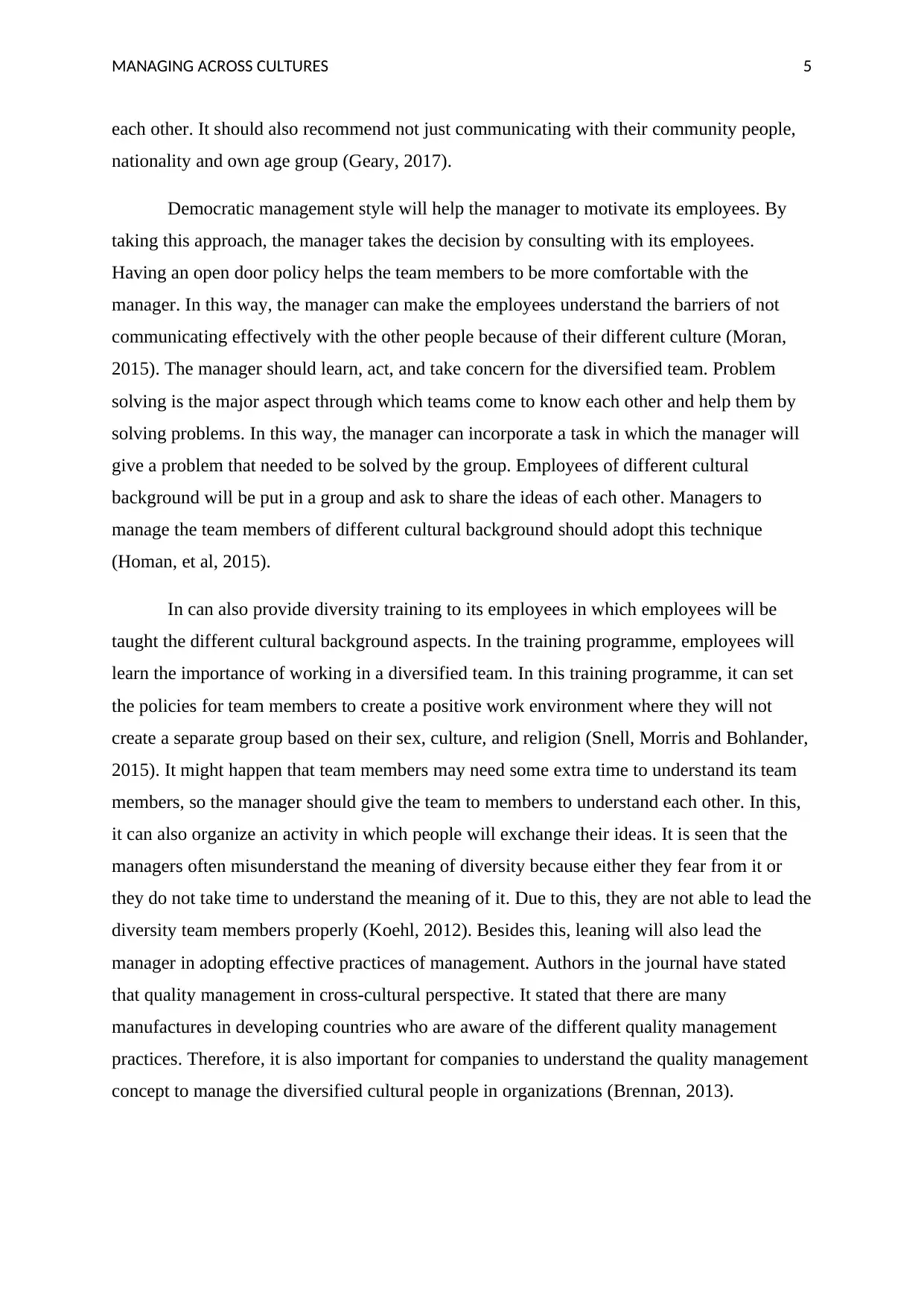
MANAGING ACROSS CULTURES 5
each other. It should also recommend not just communicating with their community people,
nationality and own age group (Geary, 2017).
Democratic management style will help the manager to motivate its employees. By
taking this approach, the manager takes the decision by consulting with its employees.
Having an open door policy helps the team members to be more comfortable with the
manager. In this way, the manager can make the employees understand the barriers of not
communicating effectively with the other people because of their different culture (Moran,
2015). The manager should learn, act, and take concern for the diversified team. Problem
solving is the major aspect through which teams come to know each other and help them by
solving problems. In this way, the manager can incorporate a task in which the manager will
give a problem that needed to be solved by the group. Employees of different cultural
background will be put in a group and ask to share the ideas of each other. Managers to
manage the team members of different cultural background should adopt this technique
(Homan, et al, 2015).
In can also provide diversity training to its employees in which employees will be
taught the different cultural background aspects. In the training programme, employees will
learn the importance of working in a diversified team. In this training programme, it can set
the policies for team members to create a positive work environment where they will not
create a separate group based on their sex, culture, and religion (Snell, Morris and Bohlander,
2015). It might happen that team members may need some extra time to understand its team
members, so the manager should give the team to members to understand each other. In this,
it can also organize an activity in which people will exchange their ideas. It is seen that the
managers often misunderstand the meaning of diversity because either they fear from it or
they do not take time to understand the meaning of it. Due to this, they are not able to lead the
diversity team members properly (Koehl, 2012). Besides this, leaning will also lead the
manager in adopting effective practices of management. Authors in the journal have stated
that quality management in cross-cultural perspective. It stated that there are many
manufactures in developing countries who are aware of the different quality management
practices. Therefore, it is also important for companies to understand the quality management
concept to manage the diversified cultural people in organizations (Brennan, 2013).
each other. It should also recommend not just communicating with their community people,
nationality and own age group (Geary, 2017).
Democratic management style will help the manager to motivate its employees. By
taking this approach, the manager takes the decision by consulting with its employees.
Having an open door policy helps the team members to be more comfortable with the
manager. In this way, the manager can make the employees understand the barriers of not
communicating effectively with the other people because of their different culture (Moran,
2015). The manager should learn, act, and take concern for the diversified team. Problem
solving is the major aspect through which teams come to know each other and help them by
solving problems. In this way, the manager can incorporate a task in which the manager will
give a problem that needed to be solved by the group. Employees of different cultural
background will be put in a group and ask to share the ideas of each other. Managers to
manage the team members of different cultural background should adopt this technique
(Homan, et al, 2015).
In can also provide diversity training to its employees in which employees will be
taught the different cultural background aspects. In the training programme, employees will
learn the importance of working in a diversified team. In this training programme, it can set
the policies for team members to create a positive work environment where they will not
create a separate group based on their sex, culture, and religion (Snell, Morris and Bohlander,
2015). It might happen that team members may need some extra time to understand its team
members, so the manager should give the team to members to understand each other. In this,
it can also organize an activity in which people will exchange their ideas. It is seen that the
managers often misunderstand the meaning of diversity because either they fear from it or
they do not take time to understand the meaning of it. Due to this, they are not able to lead the
diversity team members properly (Koehl, 2012). Besides this, leaning will also lead the
manager in adopting effective practices of management. Authors in the journal have stated
that quality management in cross-cultural perspective. It stated that there are many
manufactures in developing countries who are aware of the different quality management
practices. Therefore, it is also important for companies to understand the quality management
concept to manage the diversified cultural people in organizations (Brennan, 2013).
⊘ This is a preview!⊘
Do you want full access?
Subscribe today to unlock all pages.

Trusted by 1+ million students worldwide
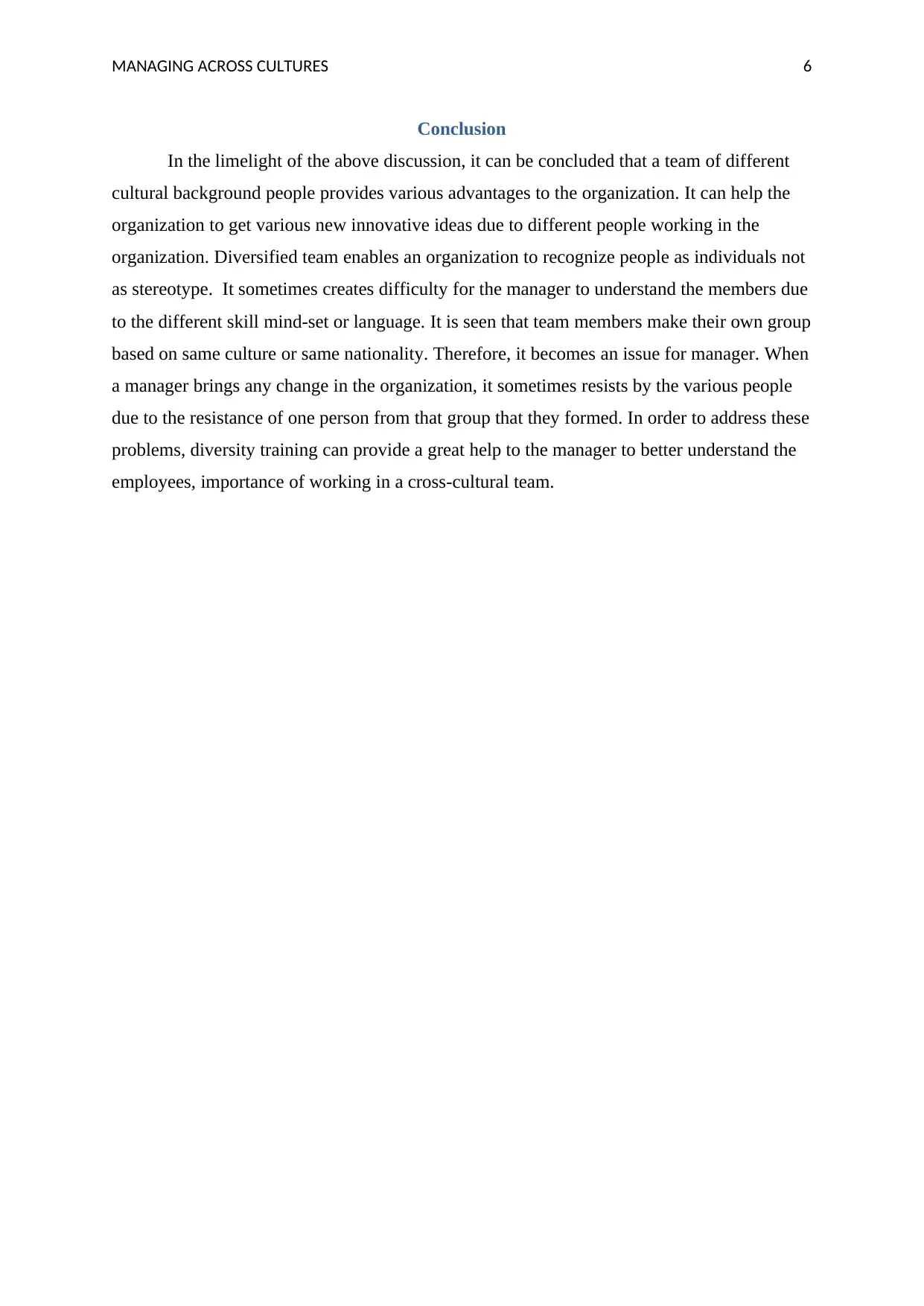
MANAGING ACROSS CULTURES 6
Conclusion
In the limelight of the above discussion, it can be concluded that a team of different
cultural background people provides various advantages to the organization. It can help the
organization to get various new innovative ideas due to different people working in the
organization. Diversified team enables an organization to recognize people as individuals not
as stereotype. It sometimes creates difficulty for the manager to understand the members due
to the different skill mind-set or language. It is seen that team members make their own group
based on same culture or same nationality. Therefore, it becomes an issue for manager. When
a manager brings any change in the organization, it sometimes resists by the various people
due to the resistance of one person from that group that they formed. In order to address these
problems, diversity training can provide a great help to the manager to better understand the
employees, importance of working in a cross-cultural team.
Conclusion
In the limelight of the above discussion, it can be concluded that a team of different
cultural background people provides various advantages to the organization. It can help the
organization to get various new innovative ideas due to different people working in the
organization. Diversified team enables an organization to recognize people as individuals not
as stereotype. It sometimes creates difficulty for the manager to understand the members due
to the different skill mind-set or language. It is seen that team members make their own group
based on same culture or same nationality. Therefore, it becomes an issue for manager. When
a manager brings any change in the organization, it sometimes resists by the various people
due to the resistance of one person from that group that they formed. In order to address these
problems, diversity training can provide a great help to the manager to better understand the
employees, importance of working in a cross-cultural team.
Paraphrase This Document
Need a fresh take? Get an instant paraphrase of this document with our AI Paraphraser
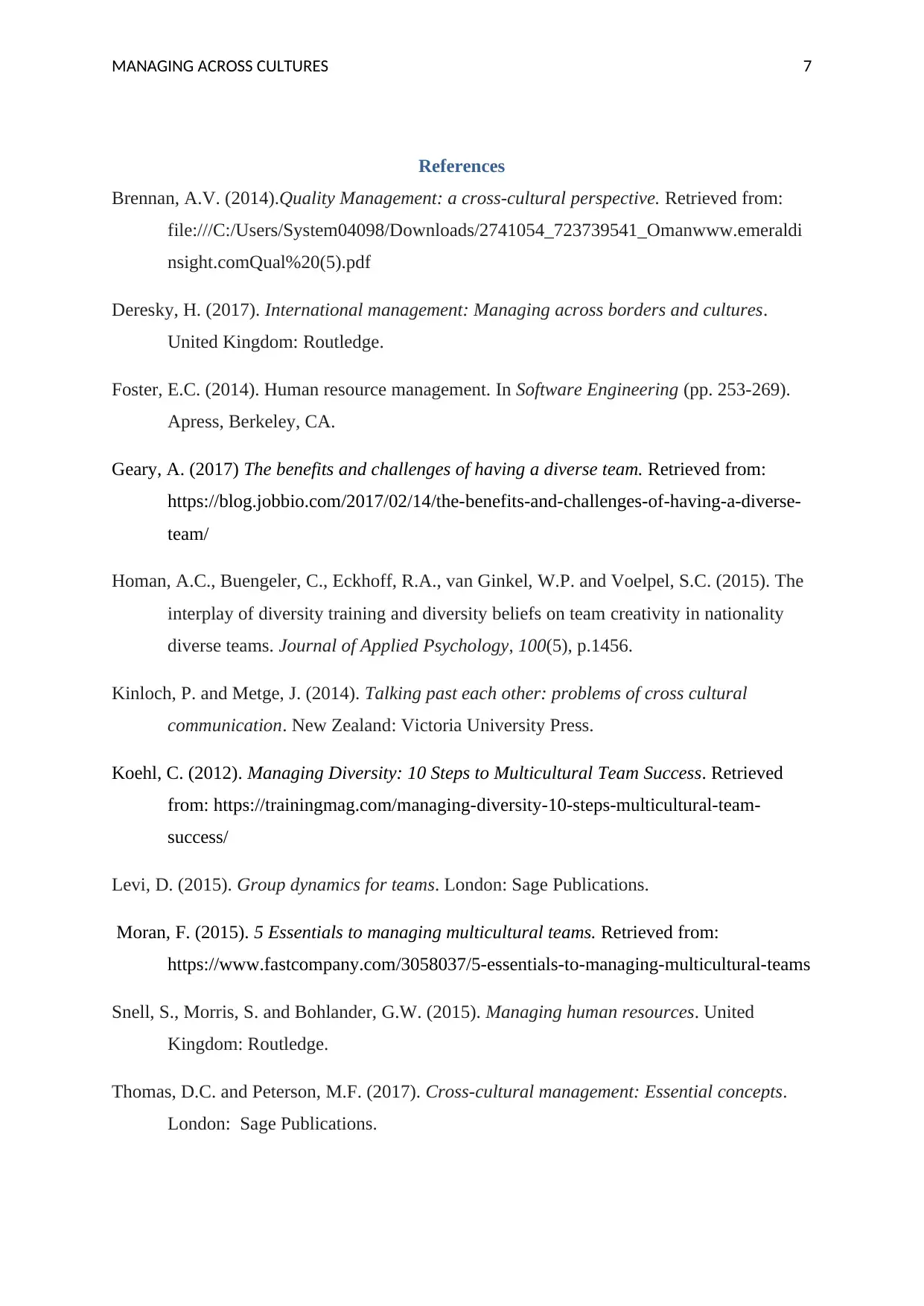
MANAGING ACROSS CULTURES 7
References
Brennan, A.V. (2014).Quality Management: a cross-cultural perspective. Retrieved from:
file:///C:/Users/System04098/Downloads/2741054_723739541_Omanwww.emeraldi
nsight.comQual%20(5).pdf
Deresky, H. (2017). International management: Managing across borders and cultures.
United Kingdom: Routledge.
Foster, E.C. (2014). Human resource management. In Software Engineering (pp. 253-269).
Apress, Berkeley, CA.
Geary, A. (2017) The benefits and challenges of having a diverse team. Retrieved from:
https://blog.jobbio.com/2017/02/14/the-benefits-and-challenges-of-having-a-diverse-
team/
Homan, A.C., Buengeler, C., Eckhoff, R.A., van Ginkel, W.P. and Voelpel, S.C. (2015). The
interplay of diversity training and diversity beliefs on team creativity in nationality
diverse teams. Journal of Applied Psychology, 100(5), p.1456.
Kinloch, P. and Metge, J. (2014). Talking past each other: problems of cross cultural
communication. New Zealand: Victoria University Press.
Koehl, C. (2012). Managing Diversity: 10 Steps to Multicultural Team Success. Retrieved
from: https://trainingmag.com/managing-diversity-10-steps-multicultural-team-
success/
Levi, D. (2015). Group dynamics for teams. London: Sage Publications.
Moran, F. (2015). 5 Essentials to managing multicultural teams. Retrieved from:
https://www.fastcompany.com/3058037/5-essentials-to-managing-multicultural-teams
Snell, S., Morris, S. and Bohlander, G.W. (2015). Managing human resources. United
Kingdom: Routledge.
Thomas, D.C. and Peterson, M.F. (2017). Cross-cultural management: Essential concepts.
London: Sage Publications.
References
Brennan, A.V. (2014).Quality Management: a cross-cultural perspective. Retrieved from:
file:///C:/Users/System04098/Downloads/2741054_723739541_Omanwww.emeraldi
nsight.comQual%20(5).pdf
Deresky, H. (2017). International management: Managing across borders and cultures.
United Kingdom: Routledge.
Foster, E.C. (2014). Human resource management. In Software Engineering (pp. 253-269).
Apress, Berkeley, CA.
Geary, A. (2017) The benefits and challenges of having a diverse team. Retrieved from:
https://blog.jobbio.com/2017/02/14/the-benefits-and-challenges-of-having-a-diverse-
team/
Homan, A.C., Buengeler, C., Eckhoff, R.A., van Ginkel, W.P. and Voelpel, S.C. (2015). The
interplay of diversity training and diversity beliefs on team creativity in nationality
diverse teams. Journal of Applied Psychology, 100(5), p.1456.
Kinloch, P. and Metge, J. (2014). Talking past each other: problems of cross cultural
communication. New Zealand: Victoria University Press.
Koehl, C. (2012). Managing Diversity: 10 Steps to Multicultural Team Success. Retrieved
from: https://trainingmag.com/managing-diversity-10-steps-multicultural-team-
success/
Levi, D. (2015). Group dynamics for teams. London: Sage Publications.
Moran, F. (2015). 5 Essentials to managing multicultural teams. Retrieved from:
https://www.fastcompany.com/3058037/5-essentials-to-managing-multicultural-teams
Snell, S., Morris, S. and Bohlander, G.W. (2015). Managing human resources. United
Kingdom: Routledge.
Thomas, D.C. and Peterson, M.F. (2017). Cross-cultural management: Essential concepts.
London: Sage Publications.

MANAGING ACROSS CULTURES 8
Ting-Toomey, S. and Dorjee, T. (2018). Communicating across cultures. New York:
Guilford Publications.
Tjosvold, D. (2017). Cross-cultural management: foundations and future. United Kingdom:
Routledge.
Van Aken, J.E. and Berends, H. (2018). Problem solving in organizations. United Kingdom:
Cambridge University Press.
Ting-Toomey, S. and Dorjee, T. (2018). Communicating across cultures. New York:
Guilford Publications.
Tjosvold, D. (2017). Cross-cultural management: foundations and future. United Kingdom:
Routledge.
Van Aken, J.E. and Berends, H. (2018). Problem solving in organizations. United Kingdom:
Cambridge University Press.
⊘ This is a preview!⊘
Do you want full access?
Subscribe today to unlock all pages.

Trusted by 1+ million students worldwide
1 out of 9
Related Documents
Your All-in-One AI-Powered Toolkit for Academic Success.
+13062052269
info@desklib.com
Available 24*7 on WhatsApp / Email
![[object Object]](/_next/static/media/star-bottom.7253800d.svg)
Unlock your academic potential
Copyright © 2020–2025 A2Z Services. All Rights Reserved. Developed and managed by ZUCOL.



